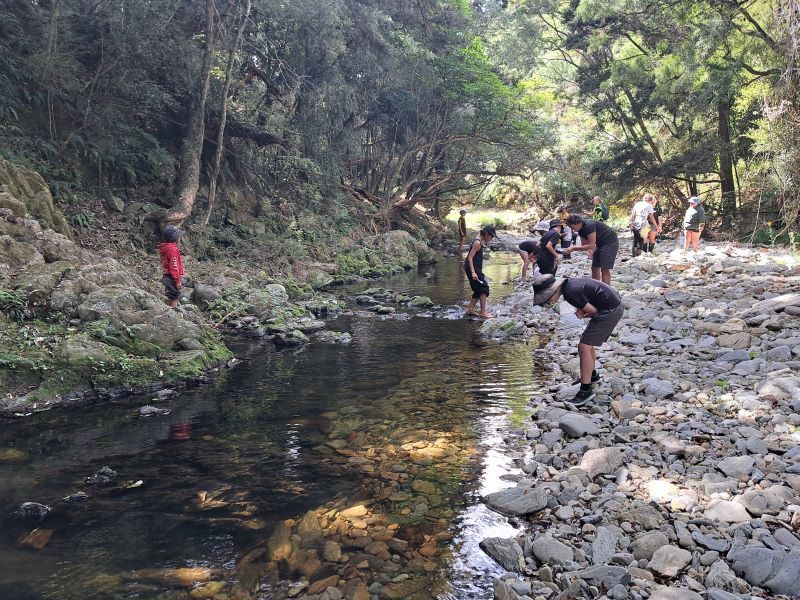Water quality educators hopeful of flow-on effect
Ashley Smyth
19 February 2023, 5:00 PM
 Hampden School pupil Braxton (7) looks into a clarity tube held by Otago Regional Council Freshwater Water Management Unit North Otago catchment advisor Benita MacLean to see how clean the Big Kuri Creek, near Hampden, is. PHOTO: Ashley Smyth
Hampden School pupil Braxton (7) looks into a clarity tube held by Otago Regional Council Freshwater Water Management Unit North Otago catchment advisor Benita MacLean to see how clean the Big Kuri Creek, near Hampden, is. PHOTO: Ashley SmythHampden School pupils whet their appetite for the environment with an outing to Big Kuri Creek last week.
The whole school, of about 40 pupils, had a hands-on opportunity to learn about water quality on the farm of Callum and Hannah Stalker, and what makes a stream healthy, courtesy of Otago Regional Council North Otago Freshwater Management Unit catchment advisor Benita MacLean.
Principal Matt Hannagan said Benita initially approached the school about taking part in a stream study.
“We instantly knew we had an excellent location to search and learn about. We also knew Noslam (North Otago Sustainable Land Management Trust), Moeraki runaka and the Stalker whanau, whose land we were on, would be interested in the activity,” he said.
The Big Kuri Creek (Kurunui) appealed because of the significance it held for the area, Matt said.
Noslam engagement officer Nicola Neal explained to the children about the diversity of wildlife in the streams, while Gareth Boyt from Moeraki runaka spoke about the native bush, and the history of the area.
“This is from an environmental perspective, but also the history of the stream, especially for mātuaranga Māori (Māori knowledge) and in more recent times, since European settlement,” Matt said.
The visit aligned with the school’s aim to learn more about the local people, places and resources embedded in the Hampden localised curriculum, and it correlated with the Aotearoa New Zealand Histories curriculum, which came into play this year.
Benita said she was teaching the children the basics of water quality, and what makes a stream healthy, through visual as opposed to technical measures. These included taking the temperature, and looking through the water, collected in large tubes, to gauge its clarity.
The purpose of the visit was to teach the children a bit more about the environment, and to be environmentally conscious, she said.
“Think about land use and how it can impact on the stream, and hopefully how it flows through their life.”
The unit, which had been established in the past year, had been working mainly with non-Enviroschools, on request, as there was a limit to how many schools could become Enviroschools.

Pupils from Hampen School check the Big Kuri Creek for wildlife, with the guidance of Noslam engagement officer Nicola Neal. PHOTO: Ashley Smyth
Hannah and Callum Stalker have owned the 250ha farm (150ha effective) for three years, after leasing it from Callum’s parents three years prior to that. They mainly finish bulls and cull cows, Hannah said.
Their children Ella (8) and Sam (5) both attend Hampden School, and Hannah had previously been involved with Noslam through a role in the environment team with DairyNZ.
“I have seen how kids really enjoy getting out on-farm and seeing science at work, so when the school mentioned they were looking to do a day with Benita, I said we would be really keen to host them down at the Kurinui site.
“We have not been taking any specific measurements of the waterways on our property but are working towards stock exclusion around the farm - we have two waterways on the property - and also making sure good management practice is carried out in our farming . . . to ensure we can maintain water quality,” she said.
“We are also looking to continue with some planting once fencing has been carried out.”
Where the waterway ran through the Stalker farm was a great example of a stream with great water quality, given it was predominantly running through ungrazed land, or “grazed very extensively with much native bush cover” before it entered the property, Hannah said.
“What we discovered on Wednesday backed this up, from seeing how great the clarity and temperatures were, as well as the diversity of life in the stream.
Matt said it was “empowering to learn about this special area on our doorstep” and that the stream was in good health.
“A rich, hands-on learning experience which was made possible by a supportive and caring community,” he said.
Noslam engagement officer Nicola Neal said, with the help of the ORC, the organisation was keen to help support more of the stream visits, and not necessarily just for children.
“It’s for engagement - do we know what’s going on in our own streams?”


